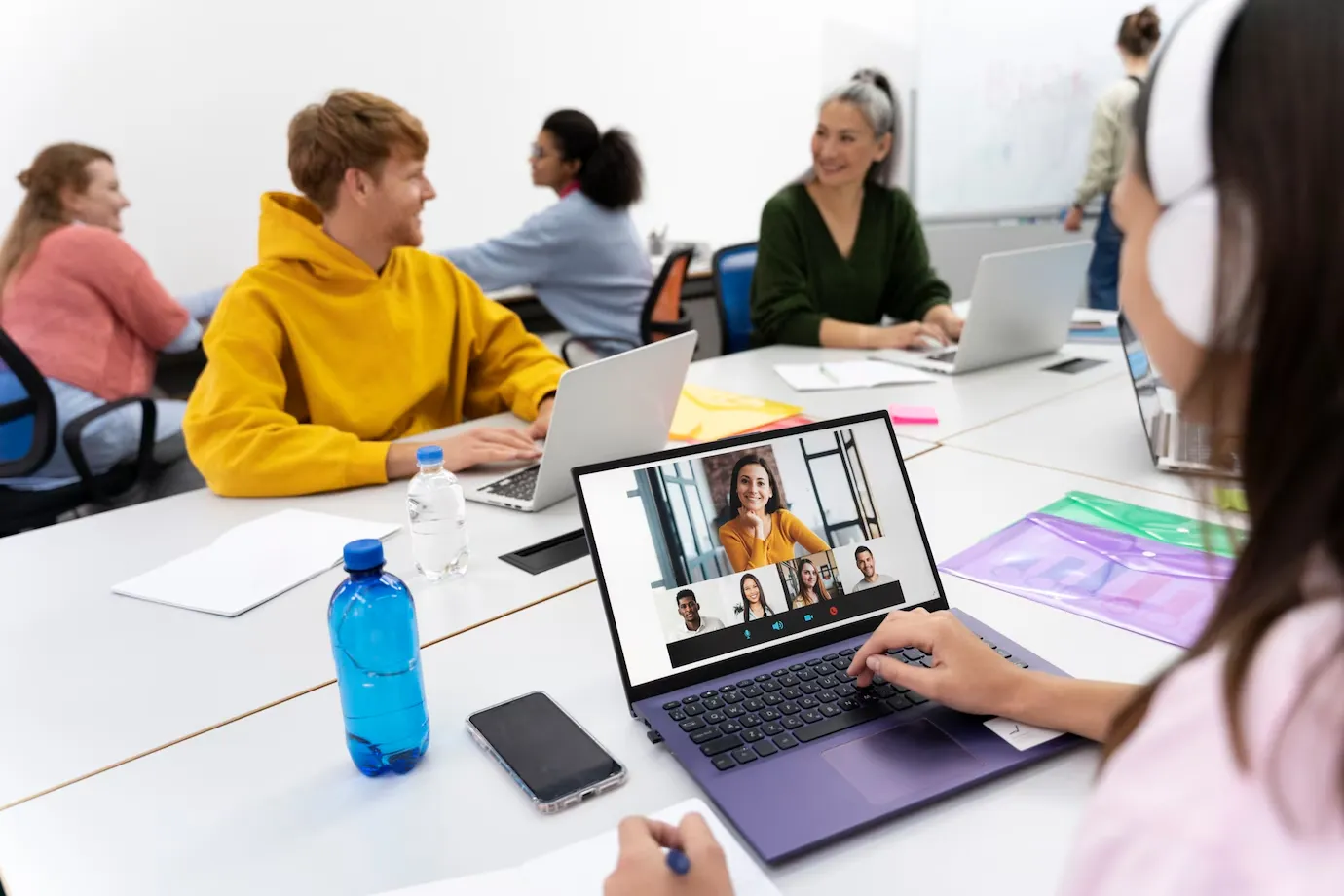The Role of Virtual Classrooms in Modern Language Education
Recently, existing trends toward remote and virtual learning have sped up despite the COVID-19 pandemic, which affected all levels of education. When the world went online in early 2020, numerous questions arose as to whether virtual classrooms could ever match the interpersonal dynamics, inspired environment, and conduciveness to the learning of languages. While we have seen great strides towards bridging distances and providing high-quality instruction virtually, that technology-enabled approach has also demonstrated the ability to leverage some perks of technology-enabled learning.
This article will explore key developments in the adoption of virtual classrooms for modern language instruction and will provide concrete instances of how virtual classrooms are now beginning to be used in 21st-century language learning in a context of interactivity, customization, and effectiveness alike in the consumer, academic, and business environments.

Democratizing Language Learning Through Virtual Access
In 2020 alone, more than 1.5 billion learners were furloughed from school in 188 countries, triggering a worldwide, unplanned study in remote learning, which highlighted the effectiveness of tools like a french speaking app to continue language education. Annoying as it was for many people, this disruption underscored just how powerful virtual classrooms were to bring the channels of language learning to anyone who couldn’t get to, access, or learn in a classroom.
Before the pandemic, EF Education, Voxy, and Duolingo already hosted millions of individual learners in a virtual language center setting. Yet, the majority of these asynchronous self-study formats did not facilitate live interaction with teachers and peers that helps students accelerate proficiency. In 2020, educators everywhere suddenly seemed to be offered new, flexible, synchronous global virtual language training tools in the form of video communication platforms such as Zoom, Microsoft Teams, and Gather.
During 2021, private education providers such as FluentCity and public universities from UC Berkeley to Australia’s RMIT were able to blend remote and in-person language provision and increase the number of virtual international exchanges. As of 2022, platforms like Oppia are even able to make available, virtually and across socioeconomic boundaries, basic literacy and numeracy education in developing countries.
Projections indicate nearly 23% of all language learners will access virtual classrooms to augment or replace traditional offerings. Let's explore key drivers of this growth and how virtual environments are being tailored to language learning needs.
Key Benefits of Virtual Language Classrooms
Although remote emergency teaching at the beginning was not easy, virtual classrooms have their own advantages for language learning, unlike traditional classrooms. The benefits of these include flexibility, customization, and access to the real content.
Flexibility
In physical classrooms, physical constraints such as scheduling and commuting limit the choices. Students can join from anywhere at times that fit their personal or professional schedules in virtual settings. They can also accommodate different attention spans better if they are shorter, more frequent sessions rather than lengthy in-person classes.
Classes also easily span international time zones to enable peer learning and collaboration opportunities that are not feasible face-to-face. Such flexibility and expanded access cater to independent, career-focused consumers seeking to pick up languages like Spanish, Mandarin, or Arabic as lifelong learners. It also allows businesses, universities, and colleges to offer language training at scale to broader audiences.
Customization
Virtual platforms are customized same way as traditional classrooms to individual goals and levels, while moving away from the one-size-fits-all curriculum found in traditional classrooms. These tools use AI power to identify strengths and weaknesses to focus on high-impact vocabulary and lessons for each learner.
Virtual groups can also be clustered based on ability to enable both remedial and advanced development, absent the stigma that struggling or excelling students may face together in person. Breakout rooms further allow teachers to provide individual coaching. Such customization allows more effective language progression for diverse needs.
Authentic Immersive Content
Games, videos, music, and media integrated into digital curricula also connect learners to authentic linguistic and cultural content more engaging than traditional textbooks or lectures. As skills develop, virtual exchange programs with international classrooms provide meaningful conversational practice and relationships unavailable locally.
Network connectivity even allows classwide participation in foreign events and tours. While lacking in-person experience, virtual immersion develops practical language abilities and confidence for real-world application.
Overall, these strengths allow virtual classrooms to serve both independent and institutional language learners in complementary ways that traditional settings cannot.
Models of Virtual Language Learning
As adoption of virtual classrooms accelerates, three primary models are emerging, catering to various consumer and institutional needs:
- Enterprise training programs
- Blended university courses
- Direct-to-consumer marketplace platforms
- Enterprise Training Programs
As global business returns to pre-pandemic levels, demand for language skills allowing employees to support international operations, clients, and stakeholders is surging. Enterprise virtual training allows customizable upskilling at scale.
Companies like EF, Pearson, and Berlitz offer branded portals where organizations can assess teams’ abilities, align language goals to strategic needs, and track progress under flexible enterprise contracts. Short lessons are structured to align vocabulary and scenario-based conversations to workplace contexts from healthcare to hospitality.
These programs are so effective in developing company-wide language capabilities without taking up employee time in traditional courses.
Blended University Courses
While there are still a few fully online degrees, universities across the world are rewriting the formula for modern language programs by strategically switching between virtual and practical parts of the learning. Students can access the lecture online and have flexible practice, while prioritizing immersive face-to-face speaking sessions on-site.
The University of Arizona, Cambridge University, the National University of Singapore, and others piloted such blended models during 2020-2021 with positive results. They are now expanding offerings from introductory to advanced levels. Specialized software platforms like Blackboard, Canvas, Moodle, and Schoology underpin integrated lesson delivery, video chat, assessment workflows, and student collaboration.
Particularly, the blended approach is appealing to commuter student populations and better supports exchange partnerships. By 2025, more than 30 percent of university modern language enrollments are likely to involve some or all virtual components.
Direct-to-Consumer Marketplaces
Finally, advancements in video, speech recognition, and AI-guided curricula are enabling personalized, self-paced virtual language apps with live teacher check-ins that are accessible directly to millions of consumer learners outside institutional programs.
Platforms like Preply, Verbling, and Italki operate two-sided marketplaces, allowing accredited teachers to directly schedule and charge for virtual sessions while helping learners identify ideal instructors based on language, specialty, availability, and pricing factors. Embedded collaboration tools even enable small group classes.
Such platforms connect over 5000 verified language instructors to assist people with offering services in common languages and in many niches, from Afrikaans to Zulu. While it was self-directed practice, virtual class sessions increased by more than 40% in 2021 and are now expected to dominate in 2025 as performance-based pricing models develop.
This shows how virtual classrooms are doing well to disrupt traditional language education in academic, enterprise, and consumer segments. Yet, with these challenges, it is nonetheless possible to successfully transition to online delivery.
Addressing the Limitations of Virtual Learning

There are obstacles associated with completely remote mastery of the language, but virtual classrooms present new opportunities in the sphere of language education. These limitations currently inhibit full replacement of in-person instruction:
- Technical barriers
- Reduced social cues
- Cheating risks
- Digital fatigue
- Technical Barriers
However, without in-person, reliable internet connectivity, microphone/webcam quality, and computer literacy continue to be prerequisites for a smooth virtual challenge. However, global improvements in 5G networks and devices continue, and in these low-bandwidth environments, there may still be obstacles to taking part in certain learning activities such as video role-playing. Likewise, software platforms can be usability obstacles to those who are not accustomed to navigating digital tools.
Currently, purely virtual classes do not provide equitable access or performance due to such technical barriers. Balancing these constraints, blended delivery, that is, combining physical and online components, tends to maximize these constraints until infrastructure finally catches up for geographies.
Reduced Social Cues
Online, the cues that are important for contextual language and culture, such as body language and facial expressions, are less perceptible. Understanding and responses in human interactions are shaped by gaze directions, nods, shrugs, and other natural reactions to conversation. Such nuances can be almost lost.
As in real immersive settings, background sights, sounds, and stimuli also trigger reactions in virtual environments. It decreases the amount of social context, and in turn it affects language development. Blended learning addresses the shortcoming by balancing the gap of immersion but adding supplemental practice for its part.
Cheating Risks
Online assessments that are not monitored also create the concern of cheating and thus do not allow for accurate skill measurement. AI analysis is able to find irregular input patterns, but cannot accurately recreate imperfect conditions for language certification and academic credit necessary for this effort. The way around this drawback in purely virtual settings is programs dedicated to participatory learning rather than exam performance.
Digital Fatigue
Staring at screens for hours can negatively impact attention, engagement, and retention compared to varied in-person activities. Just as with office work, online learners face digital fatigue risks that challenge class interactivity and satisfaction. Short, varied virtual lessons that balance conversation, games, media, and breakout rooms counteract this factor but generally work best alongside some face-to-face learning.
While advancing technology and pedagogy continue improving remote language proficiency potential, these inherent barriers lead most experts to recommend blended classroom environments.
Realizing the Promise of Blended Language Learning
Blended models mix online as well as on-campus aspects to offer the very best feasible delivery in the area of language education, each with its own easy and onsite immersion benefits. Leveraging this approach, universities, companies, and platforms are pioneering holistic blended designs, expanding access and outcomes through technologies like:
- Asynchronous video lessons for flexible first exposure to new concepts
- AI-guided mobile apps for personalized vocabulary-building strength
- Virtual small group sessions for conversational practice
- Physical language labs for immersive simulations
- In-person workshops focused on culture and travel
- Hybrid assessment protocols combining remote and supervised testing
These developed integrated designs enable learners to get basic exposure and strengths to work independently on the digital components and emphasize the physical presence of the full class on higher levels of speaking, listening and cultural involvement.
Already, this balance is better at initial retention and mastery results than either remote or face-to-face alone. It allows customization and access to virtual classrooms as a way to overcome inherent barriers to the effective application of language abilities. By democratizing and optimizing modern language education in the 21st century, blended learning can do both.
Future Outlook for Virtual Language Classrooms
With the advancement of platforms and computing power, as well as the launch of a new generation of users through education, virtual language learning, which is in its infancy, is expected to be ubiquitous across consumers, academia, and enterprise.
As blended models gain dominance, purely virtual alternatives will still play important niche roles serving:
- Geographically dispersed learners are unable to access physical hubs
- Budget-conscious consumers are prioritizing cost savings
- Learners with limiting mobility conditions or health risks
- General hobbyists focused more on flexible cultural exchange over academic credit
For these specialty cases, advances in augmented and virtual reality, holographic projection, and spatial audio may soon enable some kind of replication of immersive social dynamics in completely foreign parts, but at a hefty price.
Conclusion
Even though traditional physical classrooms offer their own benefits to language learning, virtual incorporation will make them more customizable, accessible, and functionally effective in the real world when compared to location-limited models of education. If blended, the zones of strengths of both online and face-to-face instruction complement each other in democratizing and optimizing language mastery.
Along with developing digital tools and connectivity, there is a promise that virtual language classrooms can hold steady to give equitable, high-quality linguistic and cultural literacy, particularly under thoughtful blended implementation.